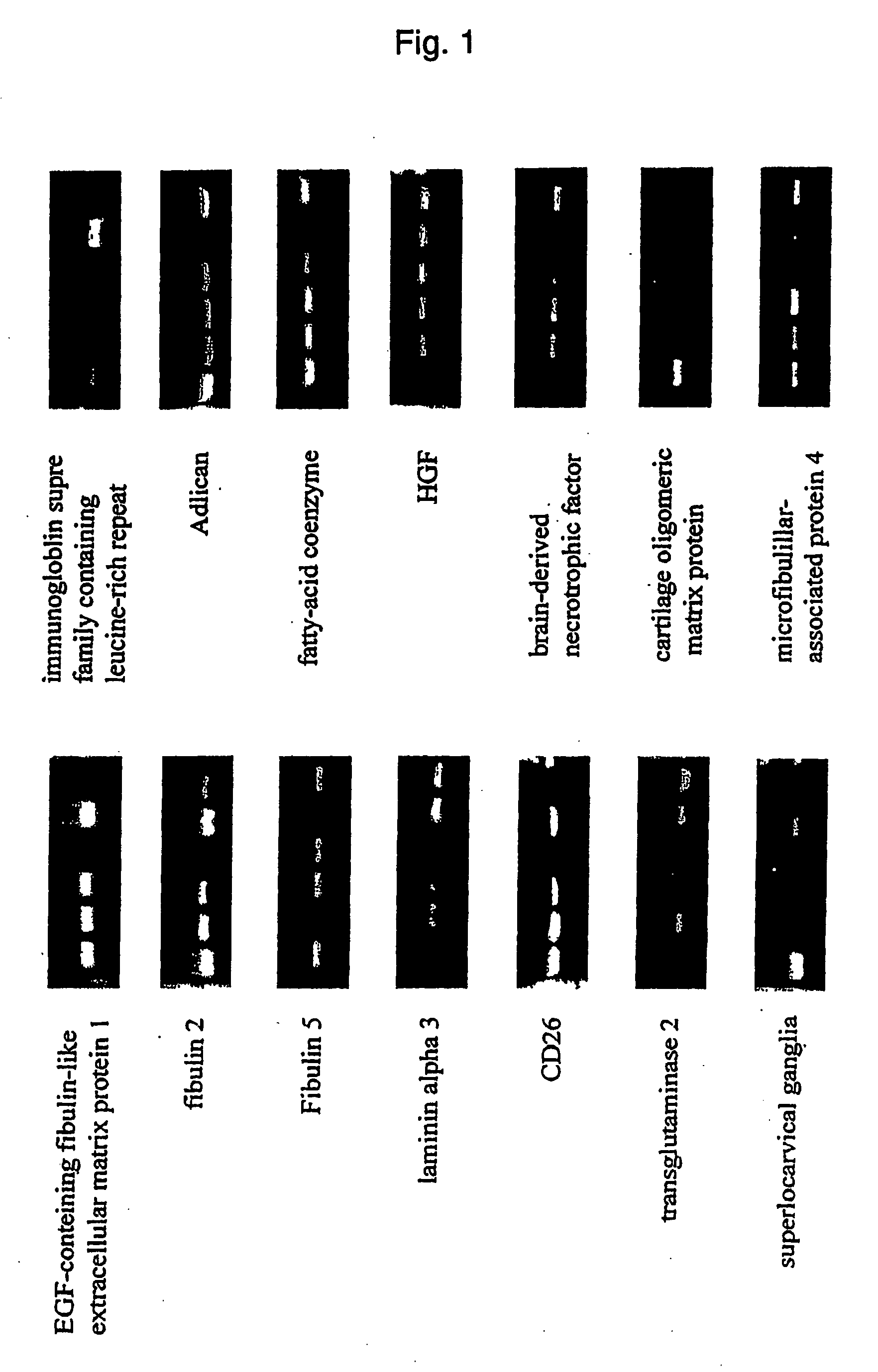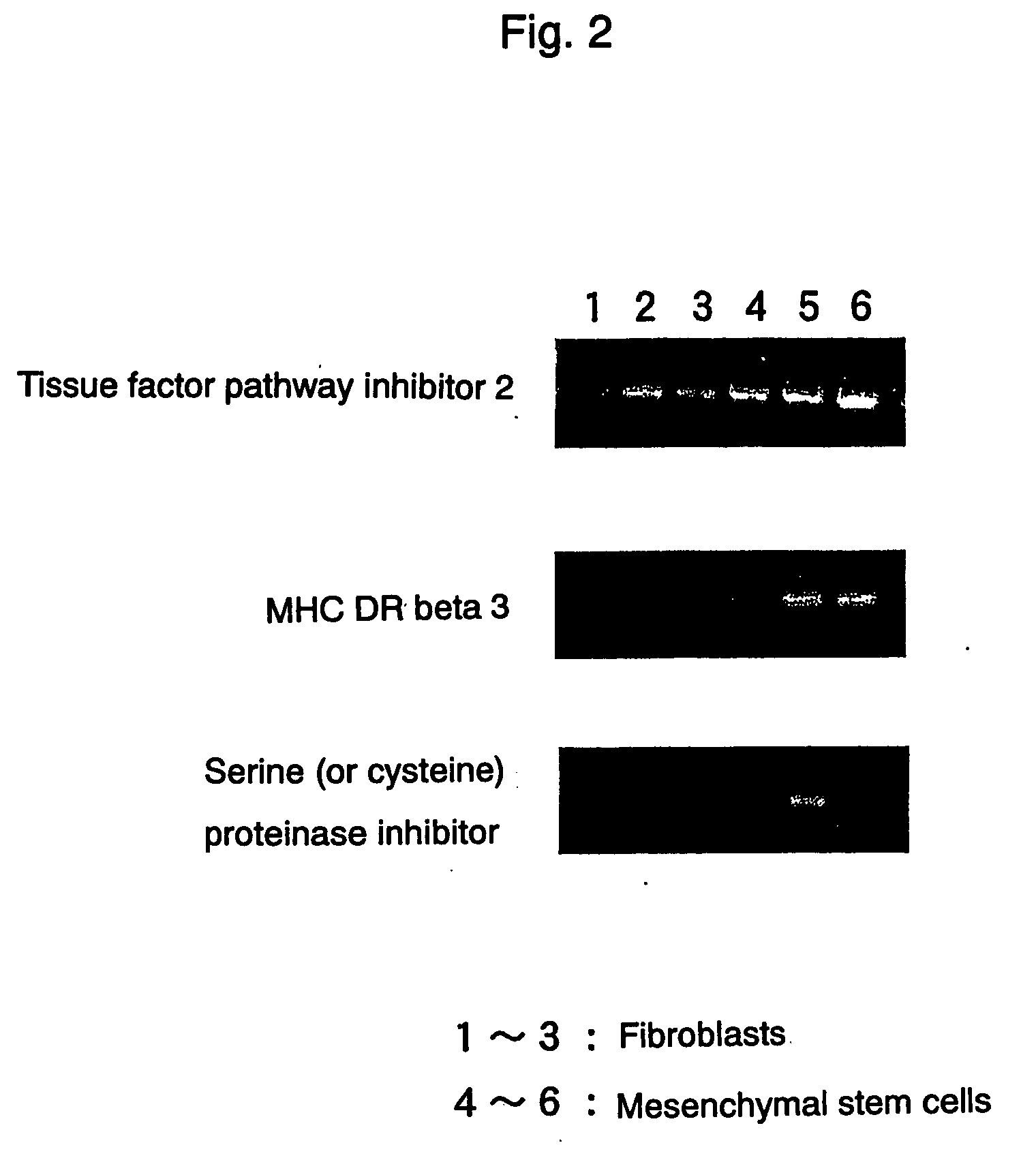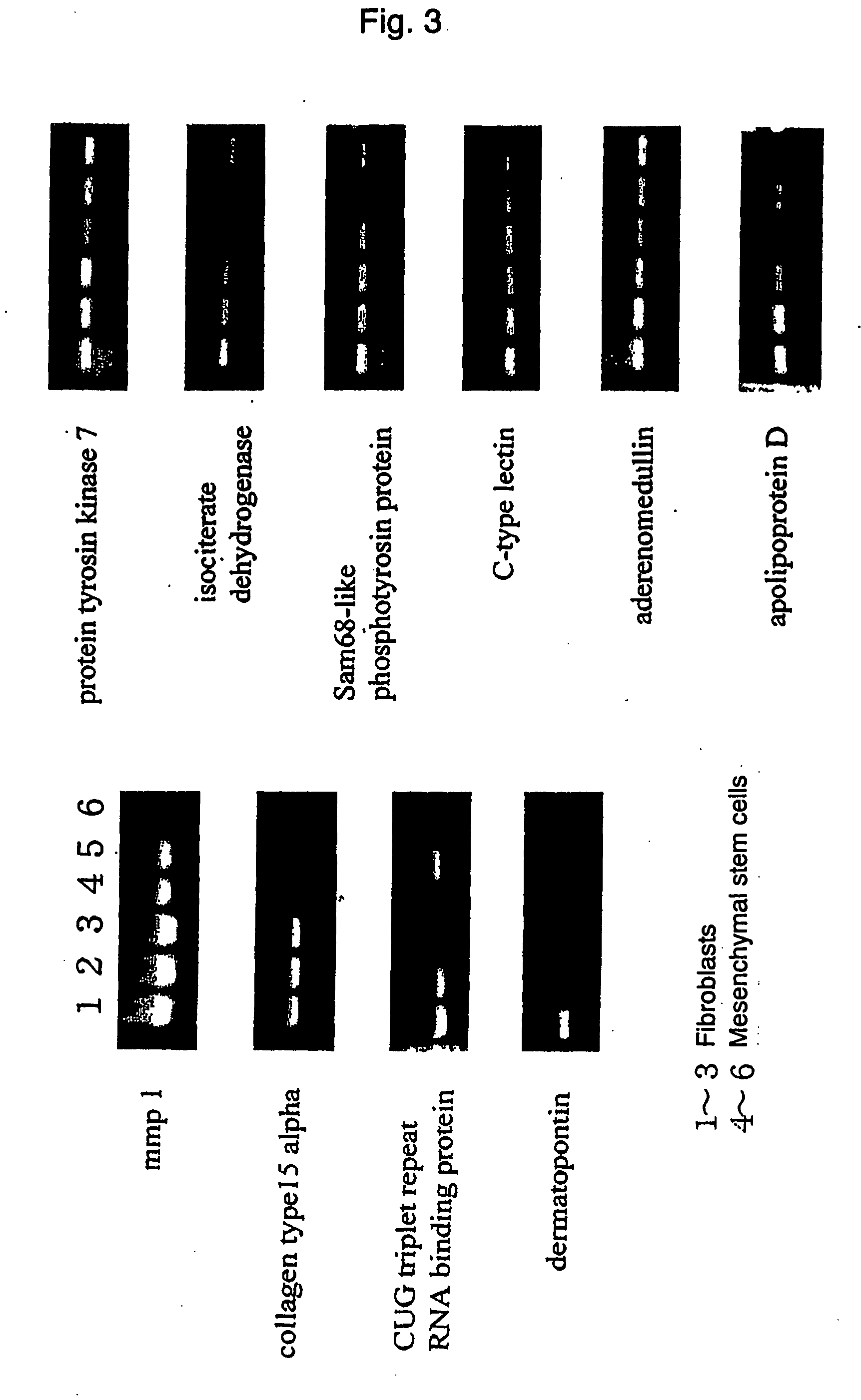Marker for detecting mesenchymal stem cell and method of distinguishing mesenchymal stem cell using the marker
a mesenchymal stem cell and marker technology, applied in the field of mesenchymal stem cell detection and separation/distincting markers, can solve the problems that the marker genes that characterize mesenchymal stem cells have not been identified
- Summary
- Abstract
- Description
- Claims
- Application Information
AI Technical Summary
Benefits of technology
Problems solved by technology
Method used
Image
Examples
example 1
Materials and Methods
(Cells)
[0057] Human mesenchymal stem cells and human fibroblasts were cultured at 37° C. in a Dalbecco's modified Eagle's medium (low glucose) (Sigma) supplemented with 10% fetal calf serum and 1 ng / ml bFGF.
[0058] Total RNA was extracted from each cell in one 10 cm-dish by using TRIZOL reagent (Invitrogen), and then mRNA was purified by using micro poly (A) purist (Ambion) to conduct DNA microarray (Incyte Genomics: Kurabo Life Array analysis service; Lot. No. KL01081). The DNA microarray analysis was commissioned to Kurabo.
(Semiquantitative RT-PCR)
[0059] Total RNA was extracted from each cell by using TRIZOL reagent (Invitrogen), and then cDNA was synthesized by conducting a reverse transcription reaction at 42° C. for 50 minutes with SuperScript first-strand synthesis system for RT-PCR (Invitrogen) using 1 mg each of total RNA as a template. Each gene was amplified with Advantage 2 PCR enzyme system (Clontech) using the amplified CDNA ...
example 2
Detection Results
[0060] As a result of DNA microarray, it was revealed that 63 out of 9400 genes exhibited significantly higher expression, and 141 out of 9400 genes exhibited significantly lower expression in mesenchymal stem cells than in fibroblasts. Significant differences were not observed in other genes. Among 87 genes which exhibited a difference of three-fold or more, 29 genes exhibited higher expression and 58 genes exhibited lower expression in mesenchymal stem cells.
(Semiquantitative RT-PCR)
[0061] Total RNAs were extracted from mesenchymal stem cells derived from 3 individuals and fibroblasts derived from 3 individuals, and by using them as a template, the expression levels of the above-mentioned 87 genes were examined by semiquantitative RT-PCR. As a result, most genes exhibited no difference in the expression levels. In addition, there were many cases wherein differences in the expression were considered to be caused by individual differences, beca...
example 3
Measurement of the Expression of Each Gene in Mesenchymal Stem Cells I
[0064] The expressions of the gene marker of the present invention in human mesenchymal stem cells and human fibroblasts were measured in the same manner as in Example 1. The primers for RT-PCR and for real time PCR, and probes for real time PCR used are shown in Table 2.
TABLE 2Primers (5′ to 3′)Primers (5′ to 3′)Probes for realGene namefor RT-PCRfor real time PCRtime PCRAdrenomedullinAGGAATAGTCGCGCAAGCATCGGTTTCCGTCGCCCTGATACCTGGGTTCGCTCGCCTTCCTCACGCATTGCACTTTTCCTCTTGAGCCCACTTATTCCACTTCTTTCAGMatrix metaroproteinaseCGACTCTAGAAACACAAGAGCAAGAGATGGACCTGGAGGAAATCTTGTCATGCTTTTCAACCAGGCCCA1AAGGTTAGCTTACTGTCACACGCTTCCGCAACACGATGTAAGTTGTACTGGTATTTissue factorGTCGATTCTGCTTTTCCGGCAACGCCAACAATTTCTACCTGGGAGGCTTGCGACGATGCpathway inhibitor 2ATGGAATTTTCTTTGGTGCGCAAACTTTGGGAACTTTTTCTATCCTSerine (or cysteine)CCAAACTTTGAAAGCCAAGGTGTGGGTGGAGAATAACACAAACAACTGGTGAAAGATTTGGTATCCCproteinase inhibitorTGCACTTCAAAGACCAGCAGGCCAGATAAGTGGCA...
PUM
| Property | Measurement | Unit |
|---|---|---|
| Temperature | aaaaa | aaaaa |
| Molar density | aaaaa | aaaaa |
| Electrical conductance | aaaaa | aaaaa |
Abstract
Description
Claims
Application Information
 Login to View More
Login to View More - R&D
- Intellectual Property
- Life Sciences
- Materials
- Tech Scout
- Unparalleled Data Quality
- Higher Quality Content
- 60% Fewer Hallucinations
Browse by: Latest US Patents, China's latest patents, Technical Efficacy Thesaurus, Application Domain, Technology Topic, Popular Technical Reports.
© 2025 PatSnap. All rights reserved.Legal|Privacy policy|Modern Slavery Act Transparency Statement|Sitemap|About US| Contact US: help@patsnap.com



